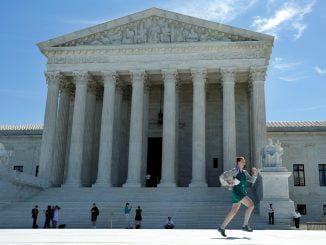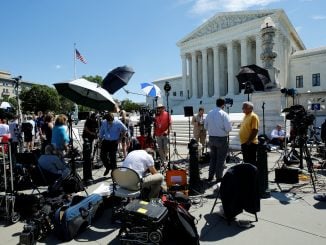
WASHINGTON, D.C. – Supreme Court justices expressed distaste on Tuesday toward the long-standing U.S. political practice of drawing electoral maps simply to entrench one party in power but appeared deeply divided over whether to do anything about it.
After the hour-long argument in the major voting rights case out of Wisconsin, it appeared that conservative Justice Anthony Kennedy, who sometimes sides with the court’s liberals in big cases, could cast the decisive vote.
Liberal justices voiced sympathy for the Democratic voters who challenged the Republican-drawn legislative map in Wisconsin as a violation of their constitutional rights. Conservative justices expressed doubt about whether courts should intervene in such highly political disputes, and questioned the challengers’ legal standing to bring the case. The court has a 5-4 conservative majority.
The court is considering the legality of partisan gerrymandering, the practice that began two centuries ago of manipulating boundaries of legislative districts to benefit one party and diminish another, and whether the Republicans who drew Wisconsin’s electoral map intended to reduce the clout of Democratic voters.
Like the other conservative justices, Kennedy questioned whether the challengers had standing to bring the claim. But he also hit the state’s lawyers with tough questions, indicating that he may think the challengers have a claim under the First Amendment of the U.S. Constitution.
A federal three-judge panel ruled 2-1 last November that Wisconsin’s redistricting plan violated the Constitution’s First Amendment right to freedom of expression and association and 14th Amendment guarantee of equal protection under the law because of the extent to which it marginalized Democratic voters. Wisconsin appealed that ruling to the high court.
In a 2004 ruling in another case, Kennedy parted with his conservative colleagues to suggest that if partisan gerrymandering went too far, courts may have to step in, and that finding a “workable standard” for deciding when to do that might be possible.
“Gerrymandering is distasteful,” conservative Justice Samuel Alito said.
The case gives the justices a chance to establish the first standards to gauge when electoral maps drawn to benefit one particular party violate the Constitution. But Alito said that if courts are going to be expected to sort out gerrymandering disputes, the standards they use will have to be manageable and avoid the appearance that they are becoming political bodies.
Alito said the metrics drawn from social science and endorsed by the lower court for gauging that electoral districts are too partisan are themselves full of questions.
‘A PINCH OF THAT’
Conservative Justice Neil Gorsuch said a court-approved formula for determining when gerrymandering is unconstitutional would be hard to achieve, comparing various standards proposed to spices on a steak dinner. “What’s the court supposed to do? A pinch of this, A pinch of that?” he asked.
Electoral maps sometimes concentrate voters who tend to favor the minority party into a small number of districts to reduce their statewide voting power – called packing – and distribute the rest of those voters in other districts in numbers too small to be a majority – called cracking.
The Democratic voters who sued Wisconsin said gerrymandering is getting more extreme due to increasingly precise voter data and mapmaking technology, leaving voters with no recourse but the courts.
The Supreme Court for decades has been willing to invalidate state electoral maps on the grounds of racial discrimination but never those drawn simply for partisan advantage.
Conservative Chief Justice John Roberts raised concerns about the high court being forced to take on a supervisory role in approving or rejecting future state electoral maps.
“We will have to decide in every case whether the Democrats or the Republicans win,” Roberts said. “The intelligent man on the street is going to say, ‘That’s a bunch of baloney.'”
Liberal Justice Ruth Bader Ginsburg raised concerns about the impact on voters if their votes do not matter because of partisan electoral maps that marginalize them.
“What incentive is there for a voter to exercise his vote?” she asked. “What becomes of the precious right to vote?”
Wisconsin’s electoral map, drawn after the 2010 U.S. census, enabled Republicans to win a sizable majority of Wisconsin legislative seats despite losing the popular vote statewide to the Democrats. The party’s majority has since expanded.
The plaintiffs’ attorney, Paul Smith, urged the justices to act. “If you let this go,” he said, “in 2020 you’re going to have a festival of copycat gerrymanders, the likes of which this country has never seen.”
“You are the only institution in the U.S. that can solve this problem,” Smith added.
Liberal Justice Stephen Breyer offered his own test for uncovering extreme partisan maps, which included asking whether a single party had control of the redistricting process, whether the maps would always favor that party, and whether the plan was an “extreme outlier.”
State and federal legislative district boundaries are reconfigured after the U.S. government conducts a census every decade, a redistricting chore typically done by the party that controls the state legislature.
A ruling is due by the end of June.




